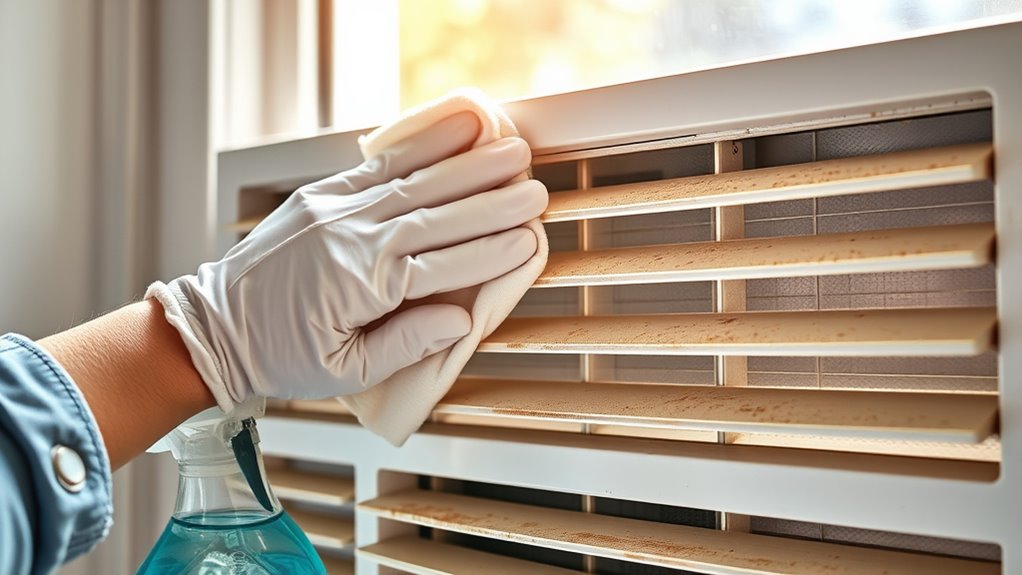To prepare your window air conditioner for summer, turn it off and unplug it first. Remove the front grille, filter, and clean or replace the filter. Use a soft brush or coil cleaner spray on the coils and fins to remove dust and dirt. Wipe interior parts with vinegar or mild disinfectant to prevent mold. Confirm everything dries completely before reassembling. Following these steps helps keep your unit running efficiently—continue exploring each step in detail to maximize your cooling system’s performance.
Key Takeaways
- Turn off and unplug the unit before cleaning to ensure safety.
- Remove and clean or replace the air filter for optimal airflow.
- Use a soft brush or coil cleaner spray to clean evaporator and condenser coils.
- Wipe interior parts and drain pan with a damp cloth, using vinegar or disinfectant to prevent mold.
- Reassemble, dry all components thoroughly, and test the unit before summer use.

Have you ever wondered how to keep your window air conditioner running efficiently and safely? Proper cleaning is essential, especially before summer hits, to ensure your unit operates at peak energy efficiency and to prevent mold growth. A dirty air conditioner not only wastes energy but can also become a breeding ground for mold, which can cause health issues and reduce indoor air quality. Taking a few simple steps now can save you money on energy bills and keep your home healthier all season long.
Regular cleaning of your window AC ensures peak efficiency and a healthier, mold-free home.
Start by turning off and unplugging your unit. Remove the front grille or cover, usually by gently pulling or unscrewing it. Once open, you’ll see the air filter—this part is crucial for maintaining energy efficiency. A clogged or dirty filter forces the unit to work harder, consuming more electricity and increasing wear and tear. Remove the filter and clean it thoroughly. If it’s washable, rinse it under running water, possibly with mild soap, and let it dry completely before reinstalling. If it’s a disposable filter, replace it with a new one. Regularly changing or cleaning your filter guarantees ideal airflow, reducing strain on the compressor and improving energy efficiency.
Next, clean the evaporator and condenser coils. Dust and dirt accumulate on these coils over time, obstructing airflow and making your unit less effective. Use a soft brush or a coil cleaner spray to gently remove debris from the coils. Be careful not to bend the fins—use a fin comb if needed. Clearing these coils allows for better heat exchange, which means your air conditioner won’t have to work as hard to cool your space, saving energy and reducing the risk of mold growth. Mold thrives in damp, dirty environments, so keeping these components clean minimizes moisture buildup that can promote mold development. Additionally, glycolic acid can be used in some cleaning routines to help break down residue and improve overall cleanliness, especially in areas prone to buildup.
Also, wipe down the interior parts, including the drain pan and surrounding areas, with a damp cloth. This prevents mold spores from settling and growing inside the unit. If you notice any mold or mildew, use a mixture of water and vinegar or a mild disinfectant to clean these areas thoroughly. Ensuring good ventilation around the unit and keeping the window frame clean also helps prevent excess moisture buildup, which can lead to mold and mildew. Remember, mold not only impacts air quality but can also damage the unit over time, leading to costly repairs.
Finally, reassemble your air conditioner, making sure everything is dry and properly connected. Plug it back in and test it to guarantee it’s running smoothly. Performing this maintenance before summer arrives guarantees your unit operates efficiently, consumes less energy, and stays mold-free. With these simple cleaning steps, you’ll enjoy a cooler, healthier home all season long while keeping your energy bills in check.
Frequently Asked Questions
How Often Should I Replace the Air Filter in My Window Air Conditioner?
You should replace your window air conditioner’s air filter every 1 to 3 months, depending on the air filter lifespan and your home’s conditions. A good rule of thumb is to check it monthly, especially during peak usage. Regular replacement keeps your unit running efficiently and improves air quality. Keep an eye on the filter; if it looks dirty or clogged, replace it sooner rather than later to maintain peak performance.
Can I Use Household Cleaners to Clean the Air Conditioner?
You might wonder if household cleaners are safe for your air conditioner, but they often aren’t the best choice. Using harsh chemicals can damage sensitive components or circulate fumes indoors. Instead, opt for eco-friendly cleaning solutions that are safe for your unit and the environment. Always check household cleaner safety labels and follow manufacturer instructions to prevent damage and make sure your air conditioner runs efficiently throughout summer.
Is It Necessary to Remove the Unit From the Window for Cleaning?
You don’t always need to remove the unit from the window for cleaning, but removing it makes cleaning outdoor components easier and more thorough. If you plan to clean the fins, coils, and filters properly, taking the unit out helps prevent water damage to your window and interior. Always follow your manufacturer’s instructions and verify power is off before removing the unit for cleaning outdoor parts.
What Are the Signs Indicating My Air Conditioner Needs Professional Servicing?
You’ll notice your air conditioner needs professional servicing if airflow reduces considerably or if you hear unusual noises. It’s worth investigating these signs because they often indicate issues like dirty filters, refrigerant leaks, or mechanical problems. Don’t ignore these symptoms, as they can worsen over time. Scheduling a service promptly ensures your unit runs efficiently and extends its lifespan, keeping you comfortable all summer long.
How Can I Prevent Mold Growth in My Window Air Conditioner?
To prevent mold growth in your window air conditioner, regularly clean and dry the filter and evaporator coils, especially after use. Keep the unit’s drainage pan clean and ensure proper airflow to reduce moisture buildup. Use mold prevention sprays if necessary, and maintain good air quality by controlling humidity levels. These steps help inhibit mold development, ensuring your AC runs efficiently and keeps your indoor air fresh and healthy.
Conclusion
Now that you’ve cleaned your window air conditioner, you’re all set for summer’s sweltering days. Remember, a well-maintained unit runs more efficiently and keeps your home cooler—no need to summon a wizard from a distant land! Just like a trusty knight, your AC will be ready to battle the heat. So, enjoy the cool comfort, and don’t forget—regular cleaning keeps your trusty cooling companion in tip-top shape for many seasons to come.










